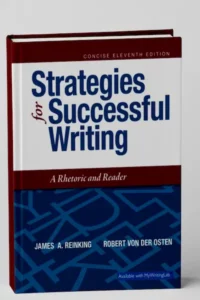Strategies for Successful Writing, 9e, offers a rhetoric, reader, research guide, and handbook, all in one convenient tool. Providing thorough coverage of the writing process and the research process, as well as strategies using the rhetorical patterns, this text also includes coverage of writing about literature and essay exams.
Also Read: Speaking and Writing Strategies for the TOEFL iBT
Strategies for Successful Writing
The Concise eleventh edition of Strategies for Successful Writing: A Rhetoric and Reader is a comprehensive textbook that offers ample material for a full-year composition course. Instructors teaching a one-term course can make selections from Chapters 1 to 18, from whatever types of specialized writing suit the needs of their students, and from appropriate essays in the Reader.
Because we strongly believe that an effective composition textbook should address the student directly, we have aimed for a style that is conversational yet clear and concise. We believe that our style invites students into the book, lessens their apprehensions about writing, and provides a model for their own prose. This style complements our strong student-based approach to writing, and together they help create a text that genuinely meets students’ needs.
Also Read: Practical IELTS Strategies IELTS Writing task 1
Changes in the Eleventh Edition
The enthusiastic response to the ten previous editions both by teachers and students has been very gratifying. The eleventh edition retains the many popular features of the previous editions and incorporates a number of improvements suggested by users and reviewers that should considerably enhance the utility of the text. Among the changes the following are noteworthy.
- Critical thinking is now a centerpiece of the text. Chapter 1 introduces students to critical thinking and how to use this text to develop their critical-thinking skills. Chapter 2 stresses critical thinking in reading; Chapters 3 and 4 identify the role of critical thinking in the writing process. Critical-thinking questions also appear throughout the Reader.
Sharpened Critical Synthesis sections appear at the end of each modes-based chapter (Chapters 8–16), helping students integrate source material regardless of which type of rhetorical strategy they are using. The section includes guidelines for prewriting, evaluating sources, planning, and drafting a source-based paper for each of the writing strategies. Each modes-based chapter also includes a section on thinking critically about the mode. - Chapter 16 on Argument has been reorganized to be easier to follow. It features a strengthened section on emotional appeal, enhanced coverage of thinking critically, and prominently located material on visual rhetoric.
- The Reader has been enhanced. Nearly half of the professional selections in the Reader have been replaced with essays from a variety of media in a range of styles on current topics, social media, immigration, citizen videos of police activity, education, and more. A new preface has been added to enhance student access to the Reader. Each modes-based section of the reader now has one selection identified as using multiple strategies with an explanation of how and why those strategies are used.
- The multimedia approach has been extended through the entire text, providing opportunities for students to write about many forms of media and to write for different media.
- The Writing About Literature chapter has been revised to include writing
about film and television, updated critical approaches, a new section on
writing explications, and a new student sample essay. - The emphasis on visual rhetoric has been strengthened. Additional revisions have been made to make the text more visually accessible and to model the best practices of visual rhetoric. Multimedia Writing Assignments in the rhetoric ask students to write about texts and visuals found in different types of media.
- In an effort to keep the text streamlined and affordable, the separate chapter on writing with multiple strategies and the section of the reader on the same topic have been integrated into the reader.
Also Read: TOEFL Integrated Writing


